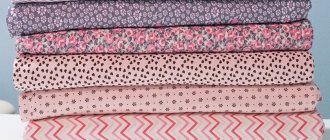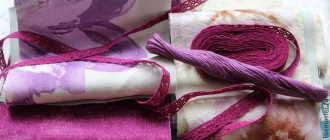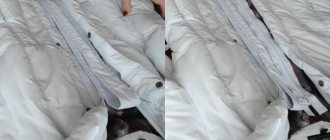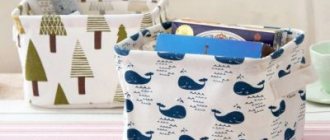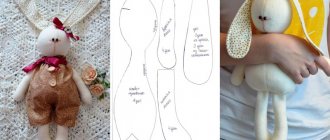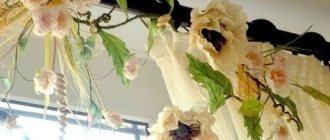Stretching the canvas
Any cotton fabric, for example, an old sheet, can play its role. You can even use colored ones; all excess colors will disappear during the preparation process. We cut the canvas to the size of the stretcher with an allowance of 3 centimeters on each side. Using a stapler, we fix it on the stretcher: fasten it on one side with 1 staple, then pull it on and fasten it on the other side, and so on one by one along each rail, along the entire perimeter. You need to tighten it so that the fabric does not sag, but does not crack, otherwise it will tear. At the corners: attach the fabric close to the corner of the stretcher, bend it over one of the ends, distribute the excess along the wrong side and staple it.
We will need:
- Subframe rail (they are sold in twos and come in different sections; for sizes up to 30 cm you can safely take the thinnest ones) More about choosing a subframe here.
- The canvas is NOT primed. The choice of canvas is a separate topic, but for the first experiments, any of those sold in stores for artists will do.
- Construction stapler and staples for it (staples are better than 6 mm)
- Breadboard knife
- Mallet (or a hammer)
- A construction spatula or a wide brush (you can’t take cheap ones - lint falls out of them). In extreme cases, you can get by with a plastic ruler.
For sizing and priming
- PVA glue
- Acrylic (can be construction grade, better beckerplast 3)
or
- Edible gelatin
- Glycerin (optional)
- Titanium white (dry pigment)
We impregnate the canvas
To glue the canvas you need to use gelatin. The size of the stretcher shown requires 2 bags. With a smaller or larger canvas size, the number of packages also changes. Soak the gelatin in water, leave for 10 to swell, then heat in the microwave until completely dissolved. Leave the dissolved gelatin to cool, but do not allow it to thicken. We coat the edges of the canvas with the liquid mixture. Pay special attention to the corners – where there are several layers of fabric. We tap the still wet corners with a hammer to remove excess fabric. We leave the canvas to dry and the gelatin to cool further. When it has already thickened, but is still easy to mix, apply it to the canvas. We do this in a circular motion, without rubbing, carefully. You can use a brush or foam sponge. If the back side is still dry, then you're doing it right. The procedure must be repeated 3 times, allowing the surface to dry.
Next comes the primer. To do this, we make a mixture of acrylic varnish and paint. The proportions are approximately 5:1 - 5 parts paint and 1 varnish. Cover the canvas with the resulting mixture. Don't forget to carefully go through the ends. After complete drying - approximately 12 hours, you need to repeat the procedure 1 or 2 times until it becomes completely white.
Assembling the subframe.
First you need to assemble the subframe. It is better to buy a modular one, as it allows you to adjust the tension of the canvas. If the format is up to 30 cm on the long side, feel free to take one that is not collapsible.
We lay the slats on the floor and connect them to each other, without trying to fit them tightly. Then we use a mallet to drive them towards each other, gradually knocking them in from all sides and making sure that the angles are 90 degrees.
Steel door
Metal is rarely used to make interior doors with your own hands, but it is an ideal option for entrance products. In order to make such a canvas you will need profiles and sheet metal.
The main stages of making a metal door
To begin with, frame racks and lintels are cut from corners and channels. They are joined together into a durable frame by spot welding. Additionally, stiffening ribs are welded on. After this, a sheet is cut out of sheet metal and welded to the prepared frame. All welds must be cleaned.
The reverse side is lined with insulation and foamed. After this, the door is covered with a sheet of plywood and additionally decorated using the method you like best.
Fabric composition and its properties
Initially, canvas was made from hemp, but it was linen fabric that became widespread, which had high strength and was more affordable.
Now the composition of the canvas can be of 3 types:
Traditional Unbleached fabric made from natural fibers.
Synthetic Fabric with polypropylene, polyamide, polyester in the composition.
Blended A combination of natural fibers with chemical additions.
Most often, canvas is made from fibers of natural origin (with the addition of chemicals):
Linen
Cotton
Jute
Canvas
Properties:
High Density
Strength and wear resistance
High hygroscopicity and water-repellent properties
Minimum light transmission
The perpendicular weave of threads in canvas fabric makes it a particularly strong and rigid material that is unpretentious in care and maintenance.
What purposes can this fabric be used for?
Canvas fabric is widely used in many industries:
Clothing Despite the stiffness and uneven color, combined fabrics are used to make clothing. Canvas is especially popular when sewing things in the “boho” style.
Textiles This includes various towels, bedspreads, curtains and napkins for the home.
Shoes, accessories, hats
Basic material for painting and artists' work
Workwear Severe fabric is often used in the manufacture of workwear for workers in various industries.
Technical purposes Canvas is used as a lining, compacting, and packaging material.
We come across different types of canvas fabric every day, often without even noticing it. In fact, the properties of the material significantly distinguish it from the natural and synthetic fabrics we are accustomed to.
Origin story
The first semblance of canvas existed in Ancient Greece, when the Romans used hemp to make clothes from it by simply weaving the fibers.
However, from the 16th century, European painters already began to officially use the material “canvas” for painting. At that time it was made mainly from flax. They liked this idea so much that it quickly spread around the world, and in the 17th century, almost all artists used this particular material to paint their paintings.
In the 19th century, canvas began to be actively popularized, and European restorers began to transfer works of art in museums from wooden bases to canvas.
In the 20th century, the use of canvas expanded, and in churches it was used to create double-sided icons - “towels”.
How to make a cardboard frame with your own hands
A do-it-yourself picture frame made of cardboard can be made by people without experience in applied arts: it is cheap, beautiful and not at all difficult. In order for everything to work out the first time, you need to immediately prepare all the elements necessary for creativity.
Cardboard is a malleable material
Who said bright frames are bad?
An interesting solution for decorating a cardboard passe-partout
Cardboard is easy to decorate
What do you need for work?
The work will require thick cardboard for the base and for the framing itself. Both simple cardboard and corrugated cardboard are suitable here: it all depends on the desired thickness and strength of the product.
The thicker the material, the more difficult it is to work with, but the stronger the result will be
In addition to the main material, we prepare scissors, a stationery knife, a glue gun with glue sticks (or, in the absence of such, we purchase wood glue or “Titan” glue for ceiling tiles). All that remains is to select everything for the exterior decor.
The hot-melt gun glues quickly and is suitable for working with cardboard
You can purchase the required jar of paint
It is much more convenient to work with a knife
Cardboard products allow you to widely use your own imagination: there are no boundaries either for shape or for decoration. You can decorate the product with textiles, beads, shells, and scrap paper.
What type of fabric is this?
Canvas is a fabric that primarily consists of plant fibers (linen and cotton), which are interconnected by a perpendicular weave. This weaving technique ensures the strength and wear resistance of the material, which is why canvas fabric is often used in industry.
Canvases are now produced in an automated way using special equipment. Factories producing this type of fabric are located in many cities and countries.
The basis of the canvas is fibers of plant origin, so they arrive at the factory in the form of compressed blocks. To turn them into single dense fabrics, the raw materials have to go through several processing stages:
Preparation of raw materials The compressed blocks of raw materials are separated, loosened and cleared of debris.
Spinning The purified material is divided into threads and sent to a spinning machine, in which short fibers are bonded and made long. The resulting yarn is wound onto bobbins.
Weaving Yarn
Processing To improve the resulting fabric, it can be subjected to boiling, bleaching, mercerization and other chemical operations that affect the external properties of the fabric.
Finished canvas sheets are rolled into rolls weighing no more than 80 kg, packed with film or packaging material and sent to warehouses.


